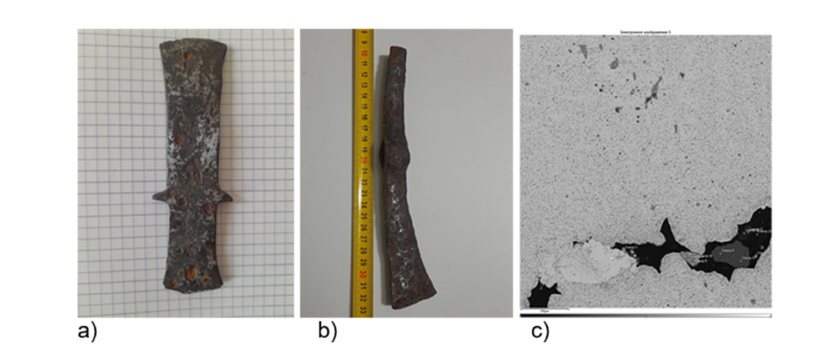- Submissions

Full Text
Progress in Petrochemical Science
The Discovery of Pure Iron Proves the Hypothesis About an Initially Hydride Earth
Tselmovich VA1* and Kamyshov AN2
1Borok Geophysical Observatory, Branch of the Institute of Earth Physics, Russian Academy of Sciences, Russia
2Baltic Escort Holding, Russia
*Corresponding author:Tselmovich VA, Borok Geophysical Observatory, Branch of the Institute of Earth Physics, Russian Academy of Sciences, Russia
Submission: October 21, 2025;Published: November 13, 2025

ISSN 2637-8035Volume7 Issue 4
Introduction
There are known archaeological finds of instruments made of Technically Pure Iron (TPI). Items from the Scythian period have been preserved in good condition, which shows the extremely high resistance of iron to corrosion. Since finds of meteorites with iron of such purity have never been recorded and the ancient nomads did not have technologies for obtaining TPI, the option of explaining the nature of the artifact from TPI within the framework of Larin VN [1] hypothesis about an initially hydride Earth is considered. The purpose of the study was to show that the artifact studied is not made of smelted steel, but of a material of natural origin, TPI, which is the cornerstone of the hydride Earth hypothesis.
Object and Research Methods
Surviving ancient literary sources report that in ancient times, two types of iron (Fe) were used to create instruments, which could be of cosmogenic and terrigenous origin:
A. The Emir of Bukhara ordered his best gunsmiths to forge him a sword from a piece «of celestial iron». But no matter how hard they tried, nothing worked. The heated iron could not be forged and the emir executed the losers [2]. This piece probably consisted of nickel iron, which is difficult to forge.
B. In his report, the Yakut governor Vasily Pushkin wrote in 1646: «Yakut foreigners have the kindest Yakut work, but they melt iron from stones not for many, not for a big cause» [3]. In 1660, the captured Pole Kamensky-Dluzhik wrote that the Yakuts were collecting iron along the Lena banks in piles, and it was as good as steel. Ross’s polar expedition in 1818 discovered that the Baffin Island Eskimos were making knives and harpoon tips at the time from iron they separated from a large meteorite lying on the shore of Melville Bay. A mention has been preserved in «Commercial Dictionary» by Vasily Levshin [4]-«this is the name of iron, completely prepared by nature in the bowels of the earth and completely purified from foreign substances so much that you can forge all sorts of things from it without melting them down. G Ruel received, through the East India Company, a piece of such native iron from Senegal, where it is located in great blocks» [2]. In Siberia, native iron is found in many places and a similar find was also noted by the authors of the article [5].
Taking into account the enormous interest in the finds of TPI, an archaeological find was studied-a hammer weighing 5kg, found at a depth of about 1 meter in the Sharya district of the Kostroma region (Morozovo tract), consisting of metallic iron (Figure 1a & 1b). The study was carried out using a Tescan Vega3 SEM, an Energy Dispersion Spectrometer (EDS) from Oxford Instruments. The main phase of the X-ray diffraction spectrum
of the studied iron-Body-Centered Cubic iron (BCC iron). Studies
carried out using SEM with EDS showed that the product consists of
TPI cleanliness Armco iron (Figure 1c)-100% Fe according to EMF
data. Ono, they have survived in working order to this day thanks
to a protective magnetite film. The material is so soft that chips
can be cut off with a knife, which is typical for TPI. Obtaining iron
of this purity was impossible at that time. Origin a small amount
of silicates and oxides found in the body of a massive piece of Fe
(Figure 1c), most likely secondary or due to physical entrapment
rather than formation in the same environment where hydride iron
is formed. Therefore, we suggested that the natural origin of iron,
which rejects versions of cosmogenic and metallurgical origin, and
fits well with the “Hydride Earth” hypothesis proposed by Larin VN
[1]. The key points of Larin’s hypothesis that support our finding
are:
a) Natural iron in the earth’s mantle: According to Larin’s
hypothesis, the earth’s deep mantle contains huge volumes of
metallic iron (in the form of solid solutions with hydrogen, i.e.
iron hydrides) and not in the form of oxides, as is customary in
standard geochemistry.
b) Hydrogen as a key element: The hypothesis suggests that
hydrogen is present in the earth in huge quantities, is associated
with metals and plays a key role in shaping the structure of the
earth, its magnetic field and even geological processes.
c) Depth material uplift: Under this hypothesis, various
geological processes (eg., volcanic eruptions, mantle plume
uplift) can bring this deep, hydrogen-and natural iron-rich
material to or close to the surface.
Figure 1:(a),(b)-type of tools made of TCG; (c) section of the product, SEM. Photograph of a pure Fe site with silicate inclusions.

Results, Discussion and Conclusion
The results obtained they agree well with the hypothesis about the natural origin of iron and not the industrial one. The high purity and absence of typical industrial alloying elements (except Mn, Ni, Co in low concentrations characteristic of natural origin) clearly indicate that this is not ordinary modern steel or cast iron. The spectrum of impurities (Ni, Co, Mn) is characteristic of natural iron, which could have formed under reducing conditions in the mantle or crust. If this iron was indeed produced under the conditions described by the Larin hypothesis (a reducing environment associated with the deep layers of the earth rich in hydrogen), then its high purity is quite expected, since under such conditions iron can crystallize in a purer form. The absence of a high carbon content (which is the main alloying element in steels) is also in line with the hypothesis. The presence of hydrogen is not shown by the analyzes, but the absence of “standard” terrestrial impurities and high values of Ni/Co/Mn ratios (or their absolute values) may indirectly indicate unusual formation conditions.
Conclusion
Analyzes of the chemical composition of the sledgehammer show that its material is very pure iron with a characteristic spectrum of impurities (Mn, Ni, Co), which is unusual for industrial iron and very typical for natural iron. This reinforces the idea that the artifact is not made of meteorite or smelted steel, but of a material of natural origin, which is the cornerstone of Larin’s VN hypothesis. It is possible that similar finds, previously noted in various parts of the earth, may be markers of hydrogen deposits.
The work was carried out under a state assignment from the Schmidt Institute of Physics of the Earth, Russian Academy of Sciences Archaeological finds of tools made of chemically pure iron are known. The objects of the Scythian period have been preserved in good condition, which shows the extremely high resistance of iron to corrosion. Since finds of meteorites with iron of such persistence have never been recorded and ancient nomads did not have the technology to acquire iron of such persistence, the option of finding an artifact made of pure iron is considered within the framework of Larin’s VN hypothesis about the originally hydride Earth. It is shown that the studied artifact is not made of smelted steel, but of a material of natural origin, which is the cornerstone of the hypothesis of the hydride Earth. It is possible that such finds can be markers of hydrogen deposits.
References
- Larin VN (2005) Our earth (origin, composition, structure and development of the originally hydride earth). Agar, Moscow, Russia, p. 248.
- Mezenin NA (1985) Interesting about the hardware. In: (3rd edn), M Metallurgy, p. 176.
- Nikolaev EN (2021) Some issues of classification of Yakut raw horns. Bulletin of Tomsk State University 465: 124-132.
- Jacques S, Alekseevich LV, Denis D, Leron DJ (1787) A commercial dictionary containing knowledge about the goods of all countries and the names of the main and newest things related to commerce, as well as house-building, knowledge of the arts, handicrafts, factories, ore works, paints, spicy potions, herbs, expensive stones, etc. Type Comp Typogr, pp. 1787-1792.-8°.
- Tselmovich VA, Shelmin VG, Maxe LP (2025) Microscopic footprints of the Chulymsky bolid, fall of 1984. Lithosphere 25(4): 961-976.
© 2025 Tselmovich VA. This is an open access article distributed under the terms of the Creative Commons Attribution License , which permits unrestricted use, distribution, and build upon your work non-commercially.
 a Creative Commons Attribution 4.0 International License. Based on a work at www.crimsonpublishers.com.
Best viewed in
a Creative Commons Attribution 4.0 International License. Based on a work at www.crimsonpublishers.com.
Best viewed in 







.jpg)






























 Editorial Board Registrations
Editorial Board Registrations Submit your Article
Submit your Article Refer a Friend
Refer a Friend Advertise With Us
Advertise With Us
.jpg)






.jpg)














.bmp)
.jpg)
.png)
.jpg)










.jpg)






.png)

.png)



.png)






